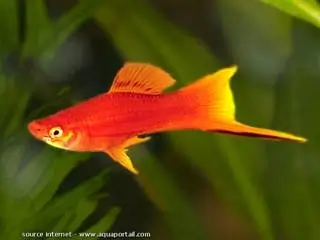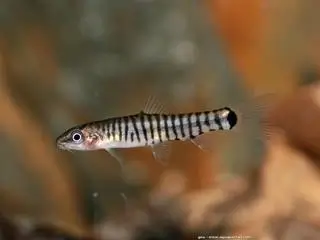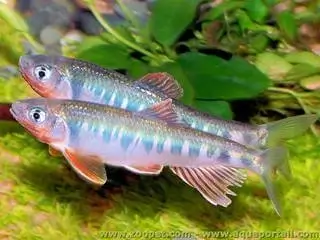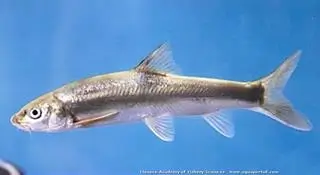Fiches poissons d'eau douce (page 32)
La page 32 de la liste des espèces de la catégorie poissons d'eau douce contient 50 fiches sur 1910 au total. Il y a 14 genres différents de Vieja à Zungaro.
Liste des fiches de Vieja hartwegi à Zungaro zungaro
- Vieja hartwegi

18,0 → 25,0 cm (> 800 L)
pH 7,0–8,0 | GH 10–30 | 24–30°C - Vieja maculicauda

18,0 → 25,0 cm (> 800 L)
pH 6,5–8,0 | GH 5–20 | 24–28°C - Vieja melanurus
 Cichlidé à tête rouge
Cichlidé à tête rouge
28,0 → 35,0 cm (> 1500 L)
pH 7,0–8,0 | GH 5–30 | 24–30°C - Vieja zonata

20,0 → 30,0 cm (> 1500 L)
pH 7,0–8,0 | GH 8–20 | 23–30°C - Wajpamheros nourissati

18,0 → 22,0 cm (> 800 L)
pH 6,5–7,5 | GH 3–10 | 26–30°C - Wallaceochromis humilis

8,5 → 11,0 cm (> 120 L)
pH 5,0–6,5 | GH 1–8 | 22–28°C
- Wallaceochromis rubrolabiatus

5,5 → 7,0 cm (> 200 L)
pH 5,0–6,5 | GH 1–5 | 23–27°C - Wallaceochromis signatus

7,0 → 9,0 cm (> 120 L)
pH 5,0–7,0 | GH 1–8 | 22–27°C - Wallaciia compressiceps
 Cichlidé-brochet nain, Crenicichla compressiceps
Cichlidé-brochet nain, Crenicichla compressiceps
5,0 → 6,0 cm (> 120 L)
pH 5,5–7,0 | GH 1–8 | 24–29°C - Wallaciia notophthalmus
 Crenicichla notophthalmus
Crenicichla notophthalmus
6,0 → 7,6 cm (> 200 L)
pH 5,0–6,0 | GH 1–5 | 24–27°C - Wallaciia regani
 Petit cichlidé-brochet, Crenicichla regani
Petit cichlidé-brochet, Crenicichla regani
6,0 → 8,0 cm (> 120 L)
pH 5,5–7,0 | GH 1–5 | 24–28°C - Wertheimeria maculata

25,0 → 35,0 cm (> 800 L)
pH 6,0–7,5 | GH 3–15 | 23–27°C - Xenomystus nigri
 Poisson-couteau africain, Notoptère noir
Poisson-couteau africain, Notoptère noir
20,0 → 30,0 cm (> 450 L)
pH 6,0–6,5 | GH 5–15 | 23–32°C - Xenotilapia boulengeri

13,0 → 16,0 cm (> 450 L)
pH 7,5–8,5 | GH 10–20 | 23–26°C - Xenotilapia flavipinnis

8,0 → 10,0 cm (> 450 L)
pH 7,5–8,5 | GH 10–20 | 23–26°C - Xenotilapia melanogenys

11,0 → 15,0 cm (> 450 L)
pH 7,5–8,5 | GH 10–20 | 23–26°C - Xenotilapia spilopterus

8,0 → 10,0 cm (> 450 L)
pH 7,5–8,5 | GH 10–20 | 23–26°C - Xenotoca eiseni
 Xénotoque d'Eisen
Xénotoque d'Eisen
6,0 → 8,0 cm (> 80 L)
pH 6,0–8,0 | GH 5–20 | 15–32°C - Xiphophorus alvarezi

6,5 → 7,5 cm (> 200 L)
pH 7,0–8,0 | GH 10–20 | 25–28°C - Xiphophorus birchmanni
 Xipho mouton
Xipho mouton
6,0 → 7,5 cm (> 80 L)
pH 7,0–8,5 | GH 8–25 | 24–28°C - Xiphophorus clemenciae
 Xipho à épée jaune
Xipho à épée jaune
4,0 → 5,5 cm (> 80 L)
pH 7,0–8,0 | GH 8–15 | 22–26°C - Xiphophorus continens
 Xipho à épée courte
Xipho à épée courte
2,5 → 3,5 cm (> 50 L)
pH 7,0–8,0 | GH 5–20 | 20–25°C - Xiphophorus cortezi

4,8 → 5,5 cm (> 80 L)
pH 7,0–8,0 | GH 8–20 | 24–28°C - Xiphophorus couchianus
 Porte-épée de Monterrey
Porte-épée de Monterrey
4,0 → 6,0 cm (> 80 L)
pH 7,0–7,5 | GH 8–12 | 27–30°C
- Xiphophorus evelynae

4,0 → 6,0 cm (> 50 L)
pH 7,0–8,0 | GH 8–15 | 15–24°C - Xiphophorus hellerii
 Xipho porte-épée
Xipho porte-épée
8,0 → 10,0 cm (> 200 L)
pH 7,0–8,0 | GH 10–30 | 16–28°C - Xiphophorus kallmani
 Porte-épée en laiton
Porte-épée en laiton
7,0 → 12,0 cm (> 120 L)
pH 6,0–7,5 | GH 3–10 | 20–26°C - Xiphophorus maculatus
 Platy
Platy
4,0 → 6,0 cm (> 120 L)
pH 7,0–8,5 | GH 8–20 | 18–28°C - Xiphophorus malinche

5,0 → 5,5 cm (> 50 L)
pH 6,5–7,5 | GH 3–12 | 15–21°C - Xiphophorus mayae
 Porte-épée maya
Porte-épée maya
6,5 → 7,6 cm (> 120 L)
pH 7,0–8,0 | GH 5–20 | 22–26°C - Xiphophorus meyeri

3,0 → 4,0 cm (> 50 L)
pH 7,0–8,0 | GH 8–20 | 23–28°C - Xiphophorus milleri
 Platy de Catemaco
Platy de Catemaco
3,0 → 4,5 cm (> 50 L)
pH 6,5–7,5 | GH 3–12 | 20–25°C - Xiphophorus montezumae
 Porte-épée du Montezuma
Porte-épée du Montezuma
5,5 → 6,5 cm (> 80 L)
pH 7,0–8,0 | GH 10–20 | 20–26°C - Xiphophorus multilineatus

2,8 → 4,0 cm (> 50 L)
pH 6,5–7,5 | GH 8–15 | 23–25°C - Xiphophorus nezahualcoyotl

5,0 → 6,0 cm (> 50 L)
pH 6,5–7,5 | GH 5–12 | 19–26°C - Xiphophorus nigrensis

5,0 → 6,0 cm (> 80 L)
pH 6,5–7,5 | GH 8–20 | 23–25°C - Xiphophorus pygmaeus
 Xipho pygmée
Xipho pygmée
3,0 → 4,0 cm (> 50 L)
pH 7,0–8,0 | GH 5–15 | 24–28°C - Xiphophorus signum

7,0 → 10,0 cm (> 120 L)
pH 7,0–8,0 | GH 10–20 | 24–28°C - Xiphophorus variatus
 Platy-perroquet
Platy-perroquet
5,0 → 8,0 cm (> 120 L)
pH 7,0–8,0 | GH 10–25 | 15–25°C - Xiphophorus xiphidium
 Platy porte-épée
Platy porte-épée
3,5 → 5,0 cm (> 50 L)
pH 7,0–8,5 | GH 15–25 | 15–26°C - Yaoshania pachychilus
 Loche-panda
Loche-panda
5,0 → 6,0 cm (> 50 L)
pH 5,5–7,0 | GH 1–8 | 15–29°C - Yasuhikotakia caudipunctata
 Loche à queue mouchetée
Loche à queue mouchetée
8,0 → 10,0 cm (> 200 L)
pH 6,0–7,5 | GH 5–15 | 24–28°C - Yasuhikotakia modesta
 Loche bleue, Botia modeste
Loche bleue, Botia modeste
18,0 → 25,0 cm (> 450 L)
pH 6,0–7,5 | GH 3–15 | 24–30°C - Yasuhikotakia splendida
 Loche splendide
Loche splendide
9,0 → 11,0 cm (> 200 L)
pH 6,5–7,5 | GH 5–15 | 26–29°C - Yunnanilus brevis
 Loche du lac Inle
Loche du lac Inle
5,0 → 7,0 cm (> 120 L)
pH 7,0–8,0 | GH 8–20 | 20–26°C - Yunnanilus cruciatus

3,0 → 3,5 cm (> 50 L)
pH 6,0–7,0 | GH 1–10 | 24–28°C - Zacco chengtui

14,0 → 20,0 cm (> 1500 L)
pH 6,0–7,5 | GH 3–12 | 10–24°C - Zacco platypus
 Chevesne ornithorynque
Chevesne ornithorynque
13,0 → 20,0 cm (> 1500 L)
pH 6,0–7,5 | GH 5–15 | 5–30°C - Zacco taliensis

20,0 → 30,0 cm (> 1500 L)
pH 6,0–7,5 | GH 3–12 | 20–26°C - Zungaro zungaro

100,0 → 140,0 cm (> 6000 L)
pH 6,5–7,5 | GH 3–15 | 20–24°C
Les données biologiques des espèces indiquent la taille en cm et, si les valeurs sont pertinentes, d'autres caractéristiques spécifiques.
